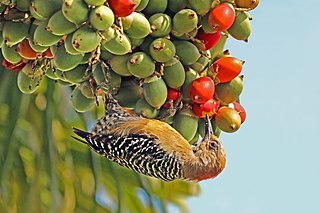
Nine families of largely arboreal birds make up the order Piciformes, the best-known of them being the Picidae, which includes the woodpeckers and close relatives. The Piciformes contain about 71 living genera with a little over 450 species, of which the Picidae make up about half.

New World barbets are near passerine birds from the family Capitonidae of the order Piciformes, which inhabit humid forests in Central and South America. They are closely related to the toucans.

The bearded barbet is an African barbet. Barbets are birds with a worldwide tropical distribution, although New World and Old World barbets are placed in different families. The barbets get their name from the bristles which fringe their heavy bills.
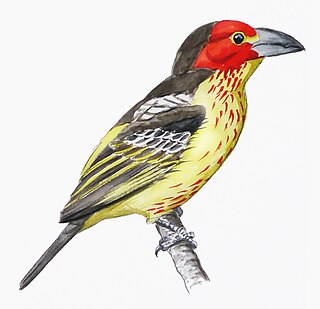
Vieillot's barbet is a small bird in the family Lybiidae. Barbets and toucans are a group of near passerine birds with a world-wide tropical distribution. The barbets get their name from the bristles which fringe their heavy bills. This bird is named after the French ornithologist Louis Pierre Vieillot.
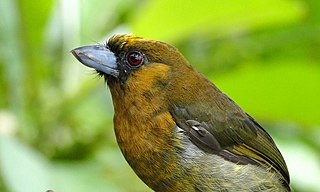
The prong-billed barbet is a distinctive, relatively large-billed bird native to humid highland forest of Costa Rica and western Panama.
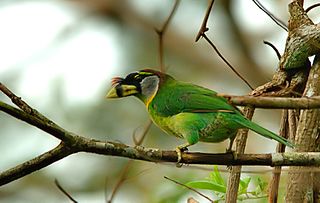
Megalaimidae, the Asian barbets, are a family of birds, comprising two genera with 34 species native to the forests of the Indomalayan realm from Tibet to Indonesia. They were once clubbed with all barbets in the family Capitonidae but the Old World species have been found to be distinctive and are considered, along with the Lybiidae and Ramphastidae, as sister groups. In the past the species were placed in three genera, Caloramphus, Megalaima and Psilopogon, but studies show that Psilopogon to be nested within the clade of Megalaima. Since members of this clade are better treated under a single genus, they have been moved to the genus Psilopogon which was described and erected earlier than Megalaima and is therefore chosen on the basis of taxonomic priority principles. Nearly all members of the family are now in the genus Psilopogon, with the exception of those in Caloramphus, which are thought to have genetically diverged from the common ancestor around 21.32 million years ago. The latter species are distinct enough to warrant placement in a subfamily Caloramphinae. The family name is derived from that of the genus Megalaima which means ‘large throat’, from the Greek mega and laimos.

Lybiidae is a family of birds also known as the African barbets. There are 42 species ranging from the type genus Lybius of forest interior to the tinkerbirds (Pogoniulus) of forest and scrubland. They are found throughout sub-Saharan Africa, with the exception of the far south-west of South Africa.
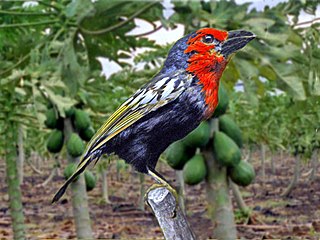
Lybius is a genus of African barbets from the family Lybiidae. This genus ranges across sub-Saharan Africa.
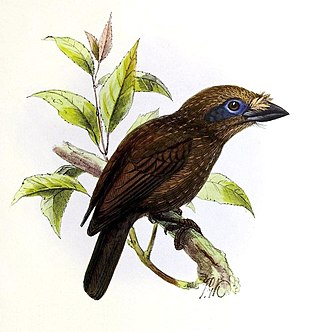
Gymnobucco is a bird genus in the African barbet family (Lybiidae), which was formerly included in the Capitonidae and sometimes in the Ramphastidae (toucans).

The double-toothed barbet is a species of bird in the family Lybiidae. It is found in Angola, Benin, Burundi, Cameroon, Central African Republic, Republic of the Congo, Democratic Republic of the Congo, Ivory Coast, Equatorial Guinea, Ethiopia, Gabon, Ghana, Guinea, Guinea-Bissau, Kenya, Liberia, Mali, Nigeria, Rwanda, Sierra Leone, South Sudan, Tanzania, Togo, and Uganda. Within Lybius bidentatus, there are two subspecies: Lybius bidentatus bidentatus and Lybius bidentatus aequatorialis.

The white-headed barbet is a species of bird in the family Lybiidae. It is found in Angola, Cameroon, Central African Republic, Chad, Democratic Republic of the Congo, Kenya, Nigeria, South Sudan, Tanzania, and Uganda.
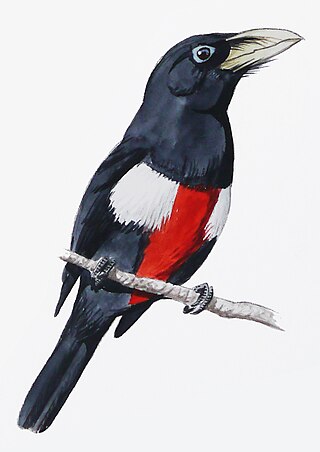
The black-breasted barbet is a species of bird in the Lybiidae family. It is found in Central African Republic, Chad, Sudan, South Sudan, and the extreme northeast of Democratic Republic of Congo and northern Uganda.

The red-faced barbet is a species of bird in the African barbet family Lybiidae. It is found in Burundi, Rwanda, Northwest Tanzania, and Southwest Uganda. Its natural habitats are dry savanna, moist savanna, and arable land. It is threatened by habitat loss.

The black-collared barbet is a species of bird in the family Lybiidae which is native to sub-Saharan Africa. Indigenous names include Rooikophoutkapper in Afrikaans, isiKhulukhulu and isiQonQotho in Zulu, and Isinagogo in Xhosa.

The banded barbet is a species of bird in the family Lybiidae. It is found in Eritrea and Ethiopia.

The African terrestrial barbets are the bird genus Trachyphonus in the African barbet family (Lybiidae), which was formerly included in the Capitonidae and sometimes in the Ramphastidae. These birds are more terrestrial than the other African barbets and differ in some other respects too; they are thus separated in a monotypic subfamily Trachyphoninae.

Tricholaema is a bird genus in the African barbet family Lybiidae. It was formerly included with the New World barbets in the family Capitonidae and sometimes also in the Ramphastidae.
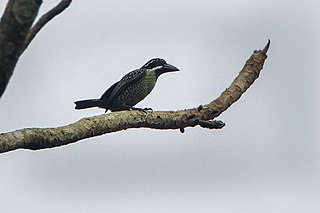
The hairy-breasted barbet is a species of bird in the family Lybiidae. It is found throughout the Africa tropical rainforest.
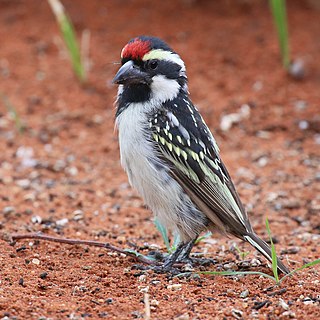
The acacia pied barbet or pied barbet is a species of bird in the family Lybiidae which is native to southern Africa.

Ramphastides is an infraorder of the order Piciformes that includes toucans and barbets. Formerly, the barbets have been classified in a single family, the Capitonidae. However, this has turned out to be paraphyletic with regard to toucans, which resulted in the Capitonidae being split into several families.
























